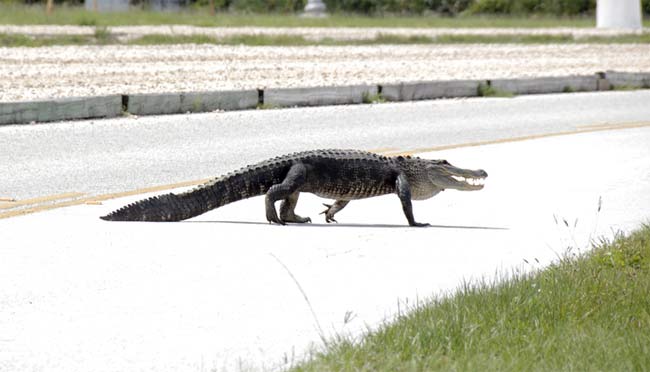Astronauts Adopt Alligator as Mascot

The space shuttle Endeavour's STS-127 mission could use someluck from its mascot.
NASA has tried twice to launch the shuttle but both times wasthwarted by a gas leak; Endeavour is now grounded until July 11 at theearliest.
Perhaps that help will come from their new mascot: analligator.
The astronauts were riding in their silver Astrovan atFlorida's Kennedy Space Center June 2 when an alligator strolled along the roadin front of them.
The toothy creature took its time walking across the SaturnCauseway ? a main road that runs through NASA's Cape Canaveral base. After itambled past the spaceflyers, the alligator headed for the woods near the road.
The seven astronauts of the space shuttle Endeavour's STS-127mission waited for the 'gator to pass before proceeding down the road toLaunch Pad 39A, where they were scheduled to rehearse liftoff procedures duringa terminal countdown demonstration test.
They were so taken by the alligator's appearance that thecrew agreed to adopt the creature as its mascot.
Get the Space.com Newsletter
Breaking space news, the latest updates on rocket launches, skywatching events and more!
Alligators are common around the space center in drainagecanals and other waters. Sometimes they venture out to the roads in search ofnew scenery or mates.
The center shares a boundary with the Merritt IslandWildlife Nature Refuge, which is a habitat for more than 310 species of birds,25 mammals, 117 fishes and 65 amphibians and reptiles.
- New Video - Meet the STS-127 Shuttle Astronauts
- End in Sight: Final Space Shuttle Missions Slated
- Image Gallery - The First 100 Space Shuttle Flights
Join our Space Forums to keep talking space on the latest missions, night sky and more! And if you have a news tip, correction or comment, let us know at: community@space.com.

Clara Moskowitz is a science and space writer who joined the Space.com team in 2008 and served as Assistant Managing Editor from 2011 to 2013. Clara has a bachelor's degree in astronomy and physics from Wesleyan University, and a graduate certificate in science writing from the University of California, Santa Cruz. She covers everything from astronomy to human spaceflight and once aced a NASTAR suborbital spaceflight training program for space missions. Clara is currently Associate Editor of Scientific American. To see her latest project is, follow Clara on Twitter.









